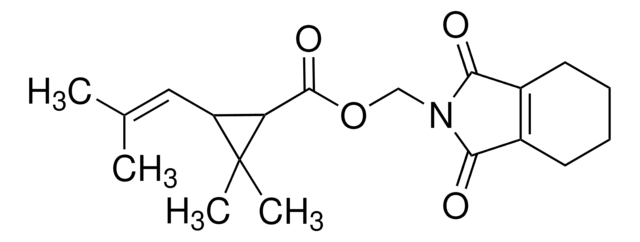60137
Potassium chloride solution
for Ag/AgCl electrodes, ~3 M KCl, saturated with silver chloride
Synonym(s):
Potassium chloride solution saturated with AgCl
Sign Into View Organizational & Contract Pricing
All Photos(1)
About This Item
Recommended Products
grade
for Ag/AgCl electrodes
Quality Level
quality
saturated with silver chloride
concentration
~3 M KCl
density
1.13 g/mL at 20 °C
InChI
1S/ClH.K/h1H;/q;+1/p-1
InChI key
WCUXLLCKKVVCTQ-UHFFFAOYSA-M
Looking for similar products? Visit Product Comparison Guide
General description
KCl exists as a white ionic solid, and can be prepared by neutralizing HCl with potassium hydroxide solution. It is less soluble in hot water as compared to cold water. It occurs naturally as the minerals carnallite and sylvine. It is generally used as a fertilizer.
Visit our Sensor Applications portal to learn more.
Application
Electrolyte filling solution for Ag/AgCl reference electrodes
Storage Class
10 - Combustible liquids
wgk_germany
WGK 3
flash_point_f
Not applicable
flash_point_c
Not applicable
ppe
Eyeshields, Gloves
Choose from one of the most recent versions:
Already Own This Product?
Find documentation for the products that you have recently purchased in the Document Library.
John Daintith
Chemistry (Weinheim An Der Bergstrasse, Germany), 223-223 (2014)
Towards a fast, high specific and reliable discrimination of bacteria on strain level by means of SERS in a microfluidic device.
Walter A.
Lab on a chip, 11 (6), 1013-1021 (2011)
Yuanyuan Qu et al.
Nucleic acids research, 41(10), 5263-5272 (2013-04-13)
Bacterial nucleoid-associated proteins, such as H-NS-like proteins in Enterobacteriaceae, are abundant DNA-binding proteins that function in chromosomal DNA organization and gene transcription regulation. The Mycobacterium tuberculosis Lsr2 protein has been proposed to be the first identified H-NS analogue in Gram-positive
Garrett A Kaas et al.
Neuron, 79(6), 1086-1093 (2013-09-21)
Dynamic changes in 5-methylcytosine (5mC) have been implicated in the regulation of gene expression critical for consolidation of memory. However, little is known about how these changes in 5mC are regulated in the adult brain. The enzyme methylcytosine dioxygenase TET1
Masatoshi Takagaki et al.
Experimental neurology, 252, 12-17 (2013-11-20)
Sedatives in the neurointensive care unit can strongly influence patients' risks of developing secondary brain damage. In particular, isoflurane, a volatile anesthetic, has been recently re-introduced to the neurointensive care unit, and first clinical studies suggest beneficial effects due to
Our team of scientists has experience in all areas of research including Life Science, Material Science, Chemical Synthesis, Chromatography, Analytical and many others.
Contact Technical Service






